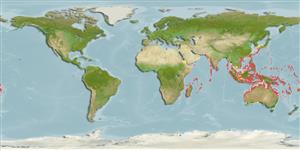Preferred temperature (Ref.
123201): 24.6 - 29.3, mean 28.4 °C (based on 3091 cells).
Phylogenetic diversity index (Ref.
82804): PD
50 = 0.5000 [Uniqueness, from 0.5 = low to 2.0 = high].
Bayesian length-weight: a=0.00741 (0.00335 - 0.01640), b=3.02 (2.83 - 3.21), in cm total length, based on LWR estimates for this (Sub)family-body shape (Ref.
93245).
Trophic level (Ref.
69278): 2.0 ±0.00 se; based on food items.
Widerstandsfähigkeit (Ref.
120179): hoch, Verdopplung der Population dauert weniger als 15 Monate. (Preliminary K or Fecundity.).
Fishing Vulnerability (Ref.
59153): Low vulnerability (10 of 100).
Nutrients (Ref.
124155): Calcium = 163 [79, 283] mg/100g; Iron = 0.886 [0.504, 1.570] mg/100g; Protein = 17.8 [16.6, 18.9] %; Omega3 = 0.0884 [, ] g/100g; Selenium = 27.3 [12.7, 63.2] μg/100g; VitaminA = 109 [26, 460] μg/100g; Zinc = 2.7 [1.7, 3.9] mg/100g (wet weight);
